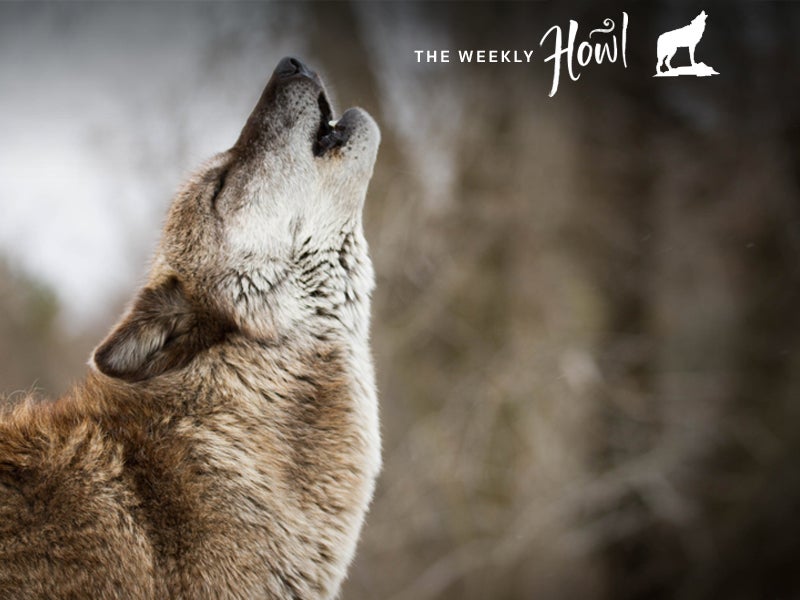Why Do Wolves Howl? Decoding the Language of Lupines
What’s hidden in a howl? This eerie sound seems to contain the essence of loneliness and lament, but to wolves, it means so much more.

This page was published 9 years ago. Find the latest on Earthjustice’s work.
Update, 3/6/19: The Trump administration has announced a plan to strip Endangered Species Act protections from wolves across almost all of the lower 48. Urge your governor to oppose this attack!
Original post, 11/3/16: Wolves have influenced human language for many thousands of years. In ancient Greece, “λύκον ἰδεῖν” meant “to see a wolf,” or to be struck dumb, apparently the result of being sighted by a wolf. The word “wulf” was one of the most common compounds in early Anglo-Saxon names, and today we lament (or sometimes celebrate) how fast we “wolf down” a meal or complain of someone who has “cried wolf” again.
Wolves utilize their own language, and recently scientists have learned that the howl of these enthralling animals changes over the course of seasons. Wolves have sophisticated social lives, which leads to a complex array of howls that signal different things.
According to Yellowstone-based biologist Doug Smith, wolves howl more or less often according to the time of year and the rhythm of their reproductive cycles. Smith was interviewed for a recent episode of NPR’s “Living on Earth.” He told NPR that during the winter, Yellowstone’s gray wolves travel in packs and call out the most frequently to warn neighboring families to stay away.
In the spring, the number of howls decreases as wolf pups are born. Smith calls the pups’ spring arrival an “anchor” for the pack. Instead of traveling together, the pack establishes dens and leaves its pups in their shelter. The pack members then split up, searching for sustenance. Each wolf howls to communicate with other pack mates, rather than with encroaching neighbors.
Wolf species also have “howling dialects,” according to a 2016 study from the University of Cambridge. Different species have their own vocal fingerprints, using specific types of howls with varying regularity. For example, a timber wolf howl is low and flat, while a red wolf howl often features a high, looping vocal.
Another study from 2013 suggests that when separated, wolves will howl out of loneliness or affection for other wolves. The scientists conducting the study concluded that a wolf howls more or less depending on the strength of its relationship with the missing wolf.
Wolf calls have not been completely demystified, nor have they lost their power to amaze. Smith vividly remembers the first moment he heard a wolf’s cry in the wild: “It came from a mile or two out and right at the end when, I swear, it came in so close I could hear the sticks snapping, the howls were booming in—it was like in the palm of your hands—[but] that wolf never stepped into the light of the moon and I never saw it.”
The tingle running down Smith’s spine, remembered decades later, is the same reason Michael Jackson’s “Thriller” begins with a haunting howl. Smith explained, “When you sit and you listen to that lone wolf howl, almost moaning … it seems to mean so much more to the individual wolf.”
The lingering mystery of a wolf’s howl creates a connection between the animal and man. It’s fun to imagine howling with the pack, or joining the family dog as he howls at a passing fire truck. In a way, we hear undercurrents of our own emotions in wolf song. And this complex connection with wolves is not limited to humans. Other animals in Yellowstone have benefited from the re-introduction of the magical, mysterious grey wolf to the park. The wolf’s howl is not something to be feared; it’s a harbinger of better days to come.
Earthjustice is continuing our fight in the courtroom on behalf of wolves, and you can help give this incredible species the chance it deserves.
Take Action: Help defend the Endangered Species Act
Wildlife could soon be under fire due to a series of regulatory rollbacks to the Endangered Species Act. Urge your congressperson to defend endangered species:
About this series
2015 marked the 20th anniversary of the reintroduction of gray wolves to the northern Rockies, and since that time wolves have been under nearly constant threat of losing their protections. The Weekly Howl provides insights and education about the gray wolf and updates on the status of its protections while celebrating the iconic species as a vital part of a functioning, healthy ecosystem. Posts ran through the summer of 2015 and resumed in the fall of 2016.